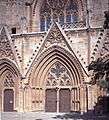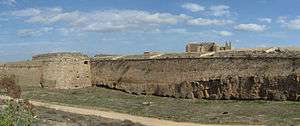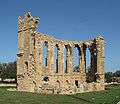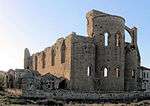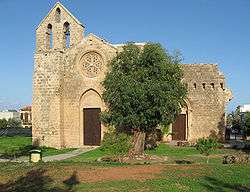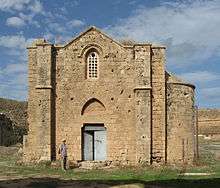Famagusta
| Famagusta | |
|---|---|
|
| |
 Famagusta | |
| Coordinates: 35°6′54″N 33°56′33″E / 35.11500°N 33.94250°E | |
| Country |
|
| • District | Famagusta District |
| Country (controlled by) |
|
| • District | Gazimağusa District |
| Government | |
| • Mayor | İsmail Arter |
| • Mayor-in-exile | Alexis Galanos |
| Population (2011)[1] | |
| • City | 40,920 |
| • Urban | 50,465 |
| Time zone | EET (UTC+2) |
| • Summer (DST) | EEST (UTC+3) |
| Website |
Turkish Cypriot municipality Greek Cypriot municipality |
Famagusta /ˌfæməˈɡʊstə, ˌfɑː-/ (Greek: Αμμόχωστος [locally [aˈmːoxostos]]; Turkish: Mağusa [mɑˈɰusɑ], or Gazimağusa [gɑːzimɑˈɰusɑ] ) is a city on the east coast of Cyprus. De facto, it is the capital of the Gazimağusa District of Northern Cyprus. It is located east of Nicosia, and possesses the deepest harbour of the island. During the medieval period (especially under the maritime republics of Genoa and Venice), Famagusta was the island's most important port city, and a gateway to trade with the ports of the Levant, from where the Silk Road merchants carried their goods to Western Europe.
Name
In antiquity, the town was known as Arsinoe (Ancient Greek: Ἀρσινόη), after Arsinoe II of Egypt, and was mentioned by that name by Strabo. In Greek it is called Ammochostos (Αμμόχωστος), meaning "hidden in [the] sand". This name developed into Famagusta (originally Famagouste in French and Famagosta in Italian), used in Western European languages, and to its Turkish name, Mağusa. In Turkish, the city is also called Gazimağusa; Gazi means veteran in Turkish, and the city has been officially awarded with the title after 1974 (compare Gaziantep). In Armenian, Famagusta is called Ֆամակուսթա Famagust'a. The old town is nicknamed "the city of 365 churches" owing to a legend that at its peak, Famagusta boasted one church for each day of the year.
History
The city was founded in around 274 BC, after the serious damage to Salamis by an earthquake, by Ptolemy II Philadelphus and named "Arsinoe" after his sister.[2] Arsinoe was described as a "fishing town" by Strabo in his Geographica in the first century BC. It remained a small fishing village for a long time.[3] Later, as a result of the gradual evacuation of Salamis due to the Arab invasion led by Muawiyah I, it developed into a small port.
Medieval Famagusta, 1192–1571


The turning point for Famagusta was 1192 with the onset of Lusignan rule. It was during this period that Famagusta developed as a fully-fledged town. It increased in importance to the Eastern Mediterranean due to its natural harbour and the walls that protected its inner town. Its population began to increase. This development accelerated in the 13th century as the town became a centre of commerce for both the East and West. An influx of Christian refugees fleeing the downfall of Acre (1291) in Palestine transformed it from a tiny village into one of the richest cities in Christendom.
In 1372 the port was seized by Genoa and in 1489 by Venice. This commercial activity turned Famagusta into a place where merchants and ship owners led lives of luxury. The belief that people's wealth could be measured by the churches they built inspired these merchants to have churches built in varying styles. These churches, which still exist, were the reason Famagusta came to be known as "the district of churches". The development of the town focused on the social lives of the wealthy people and was centred upon the Lusignan palace, the Cathedral, the Square and the harbour.
-

Territories, colonies and trade routes of the Republic of Genoa
-

Territories, colonies and trade routes of the Republic of Venice
Ottoman Famagusta, 1571–1878

In 1570–1571, Famagusta was the last stronghold in Venetian Cyprus to hold out against the Turks under Mustafa Pasha. It resisted a siege of thirteen months and a terrible bombardment, until at last the garrison surrendered. The Ottoman forces had lost 50,000 men, including Mustafa Pasha's son. Although the surrender terms had stipulated that the Venetian forces be allowed to return home, the Venetian commander, Marco Antonio Bragadin, was flayed alive, his lieutenant Tiepolo was hanged, and many other Christians were killed.[4] Lord Kinross, in his book, The Ottoman Centuries, describes the situation before the siege as follows:
The Venetians had for some time neglected this far eastern outpost of their Mediterranean dominions, and its population had greatly declined. The bulk of it was composed of Greek Orthodox peasants who were oppressed by the Frankish ruling class, and it was estimated that there were some fifty thousand serfs who would be ready to join the Turks. Sultan Selim (II) in a firman, or decree, now instructed his neighbouring sanjak bey to do his utmost to win the hearts of the masses, adding a solemn promise that in the event of the island's capture the population would not be molested and their property would be respected. Such was a formula, here strictly observed, which had for long preceded acts of Turkish expansion.
He describes the situation of the island after the fall of Famagusta as follows:
Venice was to cede the island to the Sultan two years later in a peace treaty which allowed for compensation sufficient to cover the cost of its conquest. Its subsequent administration was enlightened enough, following the standard Ottoman practice at this time in conquered territories. The former privileges of the Greek Orthodox Church were revived at the expense of the Latin Catholics, and its property restored to it. The Latin system of serfdom was abolished. The land which had formerly belonged to the Venetian nobility was transferred to the Ottoman state. The local inhabitants were assisted by the development of economic and financial resources. Large numbers of settlers were brought to the island from central Anatolia, with their cattle and farming implements.

At last, after the great calamity which had reduced the island to misery, somehow or other the poverty-stricken inhabitants began little by little to address themselves again to the culture of the soil, to some small commerce with strangers, and to those few arts which still survived in the towns. At the very beginning the dues and outgoings did not press so very hard on the rajah, because the Porte knew how the country had been impoverished by the war: and the Pashas sent to govern it were to some extent controlled by the Porte, lest their harshness should drive the rajah to leave the island, or at least to revolt, for which his degraded condition would be an excuse. So that after fifteen or twenty years the Christians redeemed nearly all the monasteries from those who had seized them, and much of the church lands as well. Churchmen of position left money for masses for the repose of their souls, or bestowed it by way of gifts.
Changes in social and cultural life had a major effect on the architectural and physical environment. In order to adjust to the socio- economic and cultural traditions of the new inhabitants, some changes were made to existing buildings. Only the main cathedral was turned into a mosque (Lala Mustafa Pasha Mosque), and the bazaar and market place were developed. Meanwhile, a theological school, baths and fountains were built to fulfill basic daily needs. With the importation of dead end streets from Ottoman culture, the existing organic town structure was enriched and a communal spirit began to assert itself. The few two-storey houses inhabited by the limited number of wealthy people balanced harmoniously with the more common one-storey houses.
British rule, 1878–1960
In the British period, the port regained significance. The enlargement of the town outside the city walls in the Ottoman period accelerated. In this period, the Turkish population generally settled in the inner town while the Greek population settled in lower and upper Varosha. During this time, British forces started to relocate Turkish families, who were majority of the population at the time, from Famagusta to the other parts of the island and mostly to the Asia-minor (Anatolia). In tune with their colonial policies, the British set up an administrative base between the Turkish and Greek quarters rather than following the convention of establishing a base in the inner town. As a result, the enlargement of the town was increasingly centered around the Varosha district. Towards the end of the British period, in parallel with socio-economic developments, and in order to meet the changing needs of the population, new residential districts were built, incorporating new housing, commercial, touristic and recreational areas. Varosha was developed in large part as a tourist resort.
In this period, the town underwent a change reflecting the then current colonial practices. The influence of British architecture was particularly apparent in the form, the details and the materials used. The British, who believed in getting close to communities under their rule by using local materials and details, employed the same practice in Famagusta. The Cyprus Government Railway, with the head offices located in Famagusta, is said to have transformed Famagusta from an old Turkish town with its own nature into a British harbour city serving Imperialist agenda.
The city was also the site for one of the two British internment camps for nearly 50.000 Jewish survivors of the Holocaust. The other camp was located at Xylophaghou (see Jews in British camps on Cyprus). However, the British failed to engage the Jewish survivors into the daily life in Famagusta and instead encouraged them to relocate to the British Mandate of Palestine. Between 1878-1960, British forces had a large impact on the population distribution in the city; Before the British takeover in 1878, the population was mostly Turkish, with Jewish and Greek minorities. During the British rule, the Jewish population had to emigrate for various reason, and the Turkish population was subsidized to grant an eventual Greek majority in the city and Cyprus.
After Independence, 1960–1974
From independence in 1960 to the Turkish invasion of Cyprus of 1974, Famagusta flourished both culturally and economically mostly due to the British investors on the island enjoying lower tax rates compared to the United Kingdom. The town developed toward the south west of Varosha as a tourist centre. In the late 1960s Famagusta became one of the world's best-known entertainment and tourist centres. These modern buildings were mostly built in Varosha. Architecture in Famagusta in this period thus reflects a desire to merge history and modernism in the pursuit of progress. From its origins as a small port in the seventh century, Famagusta in the 1970s had become a town which now displayed the universal trends of the modern architectural movement.
The contribution of Famagusta to the country's economic activity by 1974 far exceeded its proportional dimensions within the country. Apart from possessing over 50% of the total hotel accommodation of Cyprus it also offered the most substantial deep-water port handling (1973) 83% of the total general cargo and 49% of the total passenger traffic to and from the island. Whilst its population was only about 7% of the total of the country, Famagusta by 1974 accounted for over 10% of the total industrial employment and production of Cyprus, concentrating mainly on light industry compatible with its activity as a tourist resort and turning out high quality products ranging from food, beverages and tobacco, to clothing, footwear, plastics, light machinery and transport equipment. It based 19.3% of the business units and employing 21.3% of the total number of persons engaged in commerce all over the island. It acted as the main tourist destination of Cyprus, hosting 31.5% of the hotels and 45% of the total bed capacity of the island.[5] Varosha acted as the main touristic and business quarters.
As capital of the largest administrative district of the country, the town was the administrative, commercial, service and cultural centre of that district. The district of Famagusta before the 1974 invasion was characterized by a strong and balanced agricultural economy based on citrus fruits, potatoes, tobacco and wheat. Its agricultural success and the good communications between the town and the district ensured a balanced population spread and economic activity, which could be considered as a model for other developing areas.
It was inevitable that the material progress described above would spawn and sustain the most fertile kind of cultural activity in the area, with Famagusta as its hub and centre. Painting, poetry, music and drama were finding expression in innumerable exhibitions, folk art festivals and plays enacted in the nearby-reconstructed ruins of the ancient Greek theatre of Salamis.
There has not been an official census since 1960 but the population of the town in 1974 was estimated to be around 60,000 not counting about 12,000–15,000 persons commuting daily from the surrounding villages and suburbs to work in Famagusta. This population would swell during the peak summer tourist period to about 90,000–100,000 with the influx of tourists from numerous European countries, mainly Britain, France, Germany and the Scandinavian countries.
The population of the city before 1974 was approximately 60,000. The plurality (26,500) was Greek Cypriots, apart with 8,500 Turkish Cypriots and 4,000 from other ethnic groups.
1974
During the second phase of the Turkish invasion of Cyprus on 14 August 1974 the Mesaoria plain was overrun by Turkish tanks and Famagusta bombed by Turkish aircraft. In two days the Turkish Army occupied the city, which had been completely evacuated by its Greek Cypriot population, who had fled into surrounding fields before the army's arrival. Most believed that once the initial violence calmed down they would be allowed to return.
As a result of the Turkish airstrikes dozens of civilians died, including tourists.[6]
Varosha
Unlike other parts of the Turkish-controlled areas of Cyprus, the Varosha suburb of Famagusta was fenced off by the Turkish army immediately after being captured and still remains in that state today. The Greek Cypriots who had fled from Varosha were not allowed to return, and journalists are banned. It has been frozen in time with, today, houses, department stores and hotels empty and looted, even to the tiles on bathroom walls.
Swedish journalist Jan-Olof Bengtsson, who visited the Swedish United Nations battalion in Famagusta port and saw the sealed-off part of the town from the battalion's observation post, described the area as a "ghost town"; he wrote in Kvällsposten on 24 September 1977: "The asphalt on the roads has cracked in the warm sun and along the sidewalks bushes are growing [...] Today, September 1977, the breakfast tables are still set, the laundry still hanging and the lamps still burning [...] Famagusta is a ghost-town."[7]
Cityscape

Famagusta's historic city centre is surrounded by the fortifications of Famagusta, built by the Venetians in the 15th and 16th centuries. Some important landmarks and visitor attractions in the old city are:[8][9][10][11]
- The Lala Mustafa Pasha Mosque
- The Othello Castle
- Palazzo del Provveditore - the Venetian palace of the governor, built on the site of the former Lusignan royal palace
- St. Francis' Church
- Sinan Pasha Mosque
- Church of St. George of the Greeks
- Church of St. George of the Latins
- Twin Churches
- Nestorian Church (of St George the Exiler)
- Namık Kemal Dungeon
- Agios Ioannis Church
- Venetian House
- Akkule Masjid
- Mustafa Pasha Mosque
- Ganchvor monastery
Economy

Famagusta is an important commercial hub of Northern Cyprus. The main economic activities in the city are tourism, education, construction and industrial production. It has a 115-acre free port, which is the most important seaport of Northern Cyprus for travel and commerce.[12][13] The port is an important source of income and employment for the city, though its volume of trade is restricted by the embargo against Northern Cyprus. Its historical sites, including the walled city, Salamis, the Othello Castle and the St Barnabas Church, as well as the sandy beaches surrounding it make it a tourist attraction; efforts are also underway to make the city more attractive for international congresses. The Eastern Mediterranean University is also an important employer and supplies significant income and activity, as well as opportunities for the construction sector. The university also raises a qualified workforce that stimulates the city's industry and makes communications industry viable. The city has two industrial zones: the Large Industrial Zone and the Little Industrial Zone. The city is also home to a fishing port, but inadequate infrastructure of the port restricts the growth of this sector.[12]
Historically, the port was the primary source of income and employment for the city, especially right after 1974. However, it gradually lost some of its importance is the economy as the share of its employees in the population of Famagusta diminished due to various reasons.[14] However, it still is the primary port for commerce in Northern Cyprus, with more than half of ships that came to Northern Cyprus in 2013 coming to Famagusta. It is the second most popular seaport for passengers, after Kyrenia, with around 20,000 passengers using the port in 2013.[15]
Politics
The mayor-in-exile of Famagusta is Alexis Galanos. İsmail Arter heads the Turkish Cypriot municipal administration of Famagusta, which remains legal as a communal-based body under the constitutional system of the Republic of Cyprus.[16] Since 1974, Greek Cypriots submitted a number of proposals within the context of bicommunal discussions for the return of Varosha to UN administration, allowing the return of its lawful inhabitants, requesting also the opening of Famagusta harbour for use by both communities. Varosha would have been returned under Greek Cypriot control as part of the 2004 Annan Plan if the plan had been accepted by the Greek Cypriot voters.[17]
Culture

The walled city of Famagusta contains many unique buildings. Famagusta has a walled city popular with tourists[18] and a vibrant nightlife.[19] Every year, the International Famagusta Art and Culture Festival is organized in Famagusta. Concerts, dance shows and theater plays take place during the festival.[20]
In an October 2010 report titled Saving Our Vanishing Heritage, Global Heritage Fund listed Famagusta, a "maritime ancient city of crusader kings", among the 12 sites most "On the Verge" of irreparable loss and destruction, citing insufficient management and development pressures.[21]
Famagusta in Literature
Famagusta's Othello Castle is the setting for William Shakespeare's play Othello.[22] The city is also the setting for Victoria Hislop's 2015 novel The Sunrise,[23] and Michael Paraskos's 2016 novel In Search of Sixpence.[24]
Sports
Famagusta was home to many Greek Cypriot sport teams that left the city because of the Turkish invasion and still bear their original names. Most notable football clubs originally from the city are Anorthosis Famagusta FC and Nea Salamis Famagusta FC, both of the Cypriot First Division, which are now based in Larnaca.
Famagusta is represented by Mağusa Türk Gücü in the Turkish Cypriot First Division. Dr. Fazıl Küçük Stadium is the largest football stadium in Famagusta.[25] Many Turkish Cypriot sport teams that left Southern Cyprus because of the Cypriot intercommunal violence are based in Famagusta.
Famagusta is represented by DAÜ Sports Club and Magem Sports Club in North Cyprus First Volleyball Division. Gazimağusa Türk Maarif Koleji represents Famagusta in the North Cyprus High School Volleyball League.[26]
Famagusta has a modern volleyball stadium called the Mağusa Arena.[27]
Education

The Eastern Mediterranean University was founded in the city in 1979.[28] The Istanbul Technical University founded a campus in the city in 2010.[29]
The Cyprus College of Art was originally founded in Famagusta by the Cypriot artist Stass Paraskos in 1969, before moving to Paphos in 1972 after protests from local hoteliers that the presence of art students in the city was putting off holidaymakers.[30]
Health
Famagusta has three general hospitals. Gazimağusa Devlet Hastahanesi, a state hospital, is the biggest hospital in city. Gazimağusa Tıp Merkezi and Gazimağusa Yaşam Hastahanesi are private hospitals.
Personalities
- Theodora (wife of Justinian I), Byzantine Empress, the most influential woman of the Byzantine Empire
- Saint Barnabas, born and died in Salamis, Famagusta
- Dr. Derviş Eroğlu, former President of Northern Cyprus
- George Vasiliou, former President of Cyprus
- Alexia Vassiliou, famous Cypriot singer
- Hal Ozsan, actor (Dawson's Creek, Kyle XY)
- Vamik Volkan, Emeritus Professor of Psychiatry
- Oktay Kayalp, current Turkish Cypriot Famagusta mayor (Northern Cyprus)
- Alexis Galanos, current Greek Cypriot Famagusta mayor (Republic of Cyprus)
- Beran Bertuğ, Governor of Famagusta, first Cypriot woman to hold this position
- Derviş Zaim, award winning film director
- Xanthos Hadjisoteriou, acclaimed Cypriot painter
- Sohrab Sami, former professional tennis player
Georgiou, George Polyviou (1901–1972) world acclaimed Cypriot painter[31]
International relations
Twin towns – Sister cities
Famagusta is twinned with:
Image gallery
Historic buildings in Famagusta
Varosha suburb of Famagusta
See also
References
- Sources consulted
- Cyprus.gov.cy (online). Republic of Cyprus government website.
- Enlart, Camille (1899). L'art gothique et la Renaissance a Chypre. Paris, pp. 251–255.
- Kyprianos (1788). History of Cyprus. Venice, p. 453
- Magusa.org (English). Official website of Famagusta.
- Gürkan, Muzaffer Haşmet (2008). Kıbrıs'ın Sisli Tarihi (in Turkish) (1st ed.). Galeri Kültür.
- Smith, William (1854). Dictionary of Greek and Roman Geography. s.v. Arsinoe
Documenatary Film: "The Stones of Famagusta: the Story of a Forgotten City" (2008; 70 min.). An award winning documentary film on the history and historical architecture of Famagusta. See also the field guide Allan Langdale, "In a Contested Realm: An Illustrated Guide to the Archaeology and Historical Architecture of Northern Cyprus,"(Grimsay Press, 2012).
- Further reading
- Weyl Carr, Annemarie (ed.), Famagusta, Volume 1. Art and Architecture (= Mediterranean Nexus 1100-1700. Conflict, Influence and Inspiration in the Mediterranean Area 2), Turnhout: Brepols Publishers, 2014. ISBN 978-2-503-54130-3
- Endnotes
- ↑ KKTC 2011 Nüfus ve Konut Sayımı [TRNC 2011 Population and Housing Census] (PDF), TRNC State Planning Organization, 6 August 2013
- ↑ "Brief History". Ammochostos Municipality. Retrieved 4 June 2015.
- ↑ Gürkan 2008, p. 16.
- ↑ Kinross, Lord (2002). Ottoman Centuries. Harper Perennial. ISBN 978-0-688-08093-8.
- ↑ "Famagusta Municipality". Famagusta.org.cy. Retrieved 2013-10-15.
- ↑ O'Malley, Brendan; Craig, Ian; Craig, Ian (2002). The Cyprus conspiracy : America, espionage, and the Turkish invasion. London: I.B. Tauris. pp. 192, 216. ISBN 978-1-86064-737-6. Cite uses deprecated parameter
|coauthors=(help) - ↑ http://www.famagusta.org.cy/default.asp?id=341
- ↑ "Gazimağusa" (PDF). TRNC Department of Tourism and. Retrieved 31 December 2015.
- ↑ "Tarihi Yerler" (in Turkish). Famagusta Municipality. Retrieved 31 December 2015.
- ↑ Dreghorn, William. "FAMAGUSTA & SALAMIS: A Guide Book". Rustem & Bro. Publishing House. Retrieved 31 December 2015.
- ↑ "What to see in Famagusta?". Cypnet. Retrieved 31 December 2015.
- 1 2 Ülkesel Fizik Plan - Bölüm VI. Bölge Strateji ve Politikaları (in Turkish). TRNC Department of City Planning. 2012. pp. 9–29.
- ↑ Guide to Foreign Investors (2004), TRNC State Planning Organization, p. 18-19.
- ↑ Atun, Ata. "Gazimağusa Limanının önemini kaybetme nedenleri ve kente olumlu ve olumsuz etkileri". journalacademic.com (in Turkish). Eastern Mediterranean University Famagusta Symposium of 1999. Retrieved 12 August 2015.
- ↑ "KKTC Limanlarında bir yılda 2 milyon ton yük" (in Turkish). Kaptan Haber. Retrieved 12 August 2015.
- ↑ The Constitution – Appendix D: Part 12 – Miscellaneous Provisions
- ↑ Mirbagheri, Farid (2010). Historical dictionary of Cyprus ([Online-Ausg.]. ed.). Lanham, Md.: Scarecrow Press. p. 62. ISBN 978-0-8108-5526-7.
- ↑ Tolgay, Ahmet. Sur içi sendromu: Bir Lefkoşa – Mağusa kıyaslaması... (Kıbrıs)
- ↑ Mağusa geceleri capcanlı (Kıbrıs)
- ↑ International Famagusta Art & Culture Festival (Lonely Planet) Retrieved on 2015-08-31.
- ↑ Global Heritage Fund | GHF
- ↑ "Shakespeare's 'Othello Tower,' victim of Cyprus's division, to reopen after facelift". Reuters. 17 June 2015. Retrieved 4 January 2016.
- ↑ Victoria Hislop, The Sunrise (London: Headline Review 2015)
- ↑ Michael Paraskos, In Search of Sixpence (London: Friction Fiction, 2016)
- ↑ http://www.ktff.net/index.php?tpl=show_all_league&league_id=19 Archived October 9, 2011 at the Wayback Machine
- ↑ STAR KIBRIS GAZETESİ – Şampiyonlar Gazi Mağusa’dan – Liselerarası Voleybol Birinciliği’nde kızlarda Gazi Mağusa Türk Maarif Koleji, erkeklerde Namık Kemal Lisesi rakiplerini y...
- ↑ http://gundem.emu.edu.tr/contents/index.php?option=com_content&view=article&id=64%3Amausa-arena-acildi&catid=44%3Aspor&Itemid=88&lang=tr Archived April 25, 2012 at the Wayback Machine
- ↑ Eastern Mediterranean University
- ↑ "Köklü ve öncü bir üniversite". Kıbrıs. 9 January 2015. Retrieved 4 January 2016.
- ↑ Michael Paraskos, 'A Voice in the Wilderness: Stass Paraskos and the Cyprus College of Art' in The Cyprus Dossier, no. 8 (2015)
- ↑ Nikita Eleni S. "George Pol. Gergiou".
- 1 2 3 "Magosa -Twin Towns". © Gazimagosa-City.sk. Retrieved 2013-10-19.
External links
| Wikimedia Commons has media related to Famagusta. |
| Wikisource has the text of the 1911 Encyclopædia Britannica article Famagusta. |
Coordinates: 35°07′N 33°57′E / 35.117°N 33.950°E
- Famagusta, 2015 NYTimes feature article
| ||||||||||||||||||||||
| ||||||||
|

